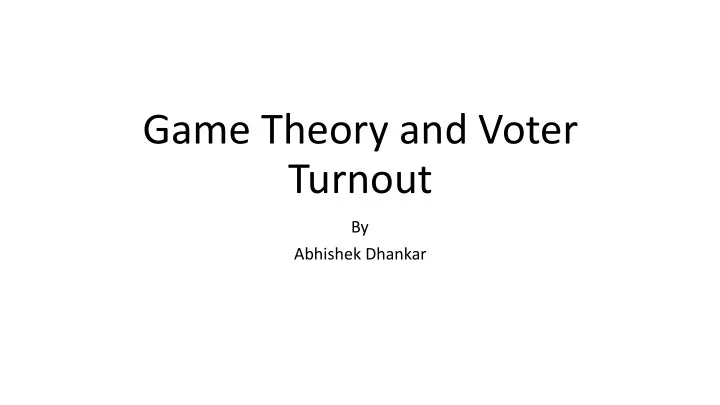

Game Theory and Voter Turnout By Abhishek Dhankar
Motivation • Election Turnout Prediction • Understand people’s motivations • How to encourage people to turn up to vote • Indian Election – April to may – 900 Million eligible voters • Create scalable models for such numbers
Economic Theory of Political Action in a Democracy - Anthony Downs (1957) • Assumption: • Universal Suffrage • Two or more Parties • Voters’ utilities are a function of govt. action • Govt.’s policies are a function of popular desires and opposition policies • Opposition Party’s policies are a function of govt’s policies and people’s utility income from incumbent’s actions • Parties’ sole purpose is to get elected
Economic Theory of Political Action in a Democracy (contd..) • Two scenarios: • Perfect Information • Imperfect Information • Perfect Knowledge: • Voters know the govt.’s and opposition’s policy function • Govt. and Opposition know voters’ utility functions • Imperfect Knowledge • Different entities have varying amounts of information • Voters might not know about all actions taken by the govt. • Voters might not know the govt.’s and opposition’s policy function
Economic Theory of Political Action in a Democracy (contd..) • Imperfect Knowledge • Some individuals will have more information than others • Individuals with less information can be swayed by those who have more information • Information is costly (time) • Voters are rational => Information is gathered only if Marginal expected utility of additional unit of information is greater than the Marginal expected cost • Marginal utility of additional information is the expected utility that will be received if the voter votes “correctly” instead of “incorrectly” • Conclusion: Individual voter’s returns from voting “correctly” are infinitesimal. It is not rational to vote since that voter’s vote is not likely to be pivotal
Critique • Number of eligible voters voting are >> 0 • Model does not take into consideration, the intrinsic utility of the act of voting
The paradox of voter participation? A Laboratory Study - DAVID K. LEVINE and THOMAS R. PALFREY (2005) • Participation (Voting) Game: • Two parties – A and B • N A , N B and f(.) Reference: Herrmann O, Jong-A-Pin R, Schoonbeek L. A prospect-theory model of voter turnout.
The paradox of voter participation? A Laboratory Study
The paradox of voter participation? A Laboratory Study • Size effect – Voter turn out reduces as Total eligible turnout increases • Competition effect – Turnout expected to be higher in elections expected to be closer • Underdog effect – The turnout is more for the candidate with fewer supporters • Experiments: • Only varied N A and N B . f is fixed • N ϵ {3, 9, 27, 51} • For each electorate size (landslide) N B = 2 N A and (tossup) N B = N A + 1 • f = uniform distribution from 0 to 55
Predicted Outcomes P *A P *B
Actual Outcomes
Behavioral Model of Turnout -Jonathan Bendor, Daniel Diermeier, Michael Ting (2003) • Non voters – Shirkers • n D and n R • , where V = Voters, S = Shirkers, I = Eligible Voter • , J = Outcome, W = Win, L = Loss • , payoff at t = time step, for agent i, (Normal Form Payoff + shock, ) • b i - c i payoff if i voted for winning side; b i payoff for shirker on winning side • - c i for losing voters and 0 for losing shirkers
• , Propensity to Vote • , aspirations • , will not adjust propensity • , will not adjust aspirations
• Propensity update for winning side • Propensity update for losing side • Aspiration update for winners and losers
Experiment • 500,000 Democrats, 500,000 Republicans • Stabilizes at 50% turnout
Altruism and Turnout - James H. Fowler • Voters will vote if PB > C, • P = Probability of winning • B = Payoff from winning • C = Cost of voting • Incorporate Altruism: • B S - Payoff for benefit to oneself • B o - Average payoff to rest of the population • α – measure of altruism
Altruism and Turnout: Dictator Game • Camerer (2003) shows that the mean allocation to player 2 ranges from 10% to 52%. • , Utility function from dictator game
Experiment • 235 subjects were recruited from two introductory undergraduate political science courses • Subjects were asked whether or not they voted in the March 2004 California primary • Played the dictator game • Asked to put themselves along the 7 point scale. 1 being democrat and 7 being Republican
Future Work • Improve reinforcement learning based model to get better results • Formulate voting policies that might encourage voting and evaluate those policies
Reference • Economic Theory of Political Action in a Democracy - Anthony Downs (1957) • The paradox of voter participation? A Laboratory Study - DAVID K. LEVINE and THOMAS R. PALFREY (2005) • Behavioral Model of Turnout -Jonathan Bendor, Daniel Diermeier, Michael Ting (2003)
Recommend
More recommend